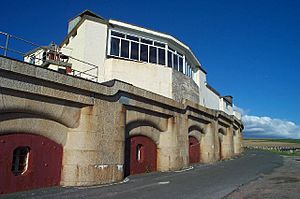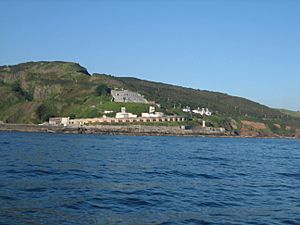Fort Bovisand facts for kids
Fort Bovisand is a strong fort located in Devon, England. It sits near the sandy Bovisand beach. This fort was built to protect the entrance of Plymouth Sound, which is a large natural harbor. It stands at a narrow point directly across from the eastern end of the Plymouth Breakwater, a long wall built in the sea. The fort is also right next to Bovisand harbour. It was constructed after a special report in 1860 suggested ways to defend the United Kingdom's coastlines.
Contents
Fort Bovisand: A Coastal Defender
Building a Stronghold

Even before the main fort, some structures were here. In 1816, a stone jetty (a landing pier) and a slip (a ramp for boats) were built. These allowed boats from sailing warships in Plymouth Sound to collect fresh water from a nearby reservoir.
The first fort at this spot, called Staddon Height Battery, began construction in 1845. This older part is still visible in the upper sections of the current fort.
Work on the main Fort Bovisand started in 1861. It was first planned to have two levels of casemates. Casemates are armored rooms or vaults in a fort where guns are placed. However, the design changed during construction. It ended up with a single level of 23 granite casemates, each protected by strong shields.
Major Whitworth Porter designed the fort, and George Baker and Company built it. The casemates were arranged in a curve. They first held 22 large 9-inch guns and one even bigger 10-inch gun. These were called Rifled Muzzle Loader (RML) guns, meaning they were loaded from the front and had grooves inside the barrel to make the cannonball spin. The fort also had living space for 180 soldiers. Deep underground tunnels were built to safely store ammunition, protecting it from enemy attacks. The fort was finished in 1869.
Guns and Upgrades
Over the years, the fort's weapons were updated. By 1880, it had 14 of the 10-inch RML guns and nine of the 9-inch RML guns. By 1893, it mounted 14 10-inch RML guns, eight 9-inch RML guns, and six 6-pounder Quick Firing (QF) guns. QF guns could be loaded and fired much faster than the older RML guns. In 1898, six 12-pounder QF guns were added. By the early 1900s, the original RML guns were considered old-fashioned, so they were removed.
During World War II, in 1942, the remaining 12-pounder guns were replaced. Two twin 6-pounder guns were installed to fight against fast enemy boats called E-boats. At the same time, a three-story observation tower was built. This tower helped direct the fire of these new guns. The next year, a Bofors 40mm anti-aircraft gun was put in place to shoot down enemy planes.
New Uses for an Old Fort
In 1956, the British Ministry of Defence stopped using coastal artillery. This meant Fort Bovisand was no longer needed for military defense. The Ministry of Defence then left the fort.
In 1970, the fort was leased out and given a new purpose. It was turned into a national school for commercial diving (diving for work) and a scuba diving center. This allowed people to learn and practice diving in a unique historical setting.
- Outdoor Activity Center: From the mid-1970s to the early 1990s, the upper part of the fort was used as an outdoor activity center for schools. The old ammunition storage areas and other buildings were changed into basic bunk houses, a kitchen, and a dining area. A cottage was used for toilets, showers, a lounge, and staff housing.
From Diving School to Heritage Site
Around 2000, the main company running the diving center went out of business. This led to many discussions about the future of the fort and the other businesses there. In December 2000, another main business at the fort also faced problems. Because of this, the owners, the Ministry of Defence, decided they could no longer keep the site open. All remaining diving and other businesses had to stop operating.
In 2003, a new diving company called Discovery Divers started up at the fort. By mid-2005, after these businesses had also struggled, the site was bought at an auction. It was purchased by a company now known as Fort Bovisand Developments Ltd. This company is owned by Greg Dyke, who used to be in charge of the BBC. His goal was to save the historic site and bring it back to life.
By mid-2008, Discovery Divers was still operating at Fort Bovisand. In 2011, a group called the Fort Bovisand Trust was formed. This is a charity dedicated to preserving the fort. They started making plans for a heritage attraction and applied for funding from the Heritage Lottery Fund. Their idea was to create a mixed project with a heritage center, a diving business, and some homes.
In 2013, the Fort Bovisand Trust received a grant from the Heritage Lottery Fund. This money helped them move forward with their plans for a heritage visitor attraction and a learning center at the fort.


